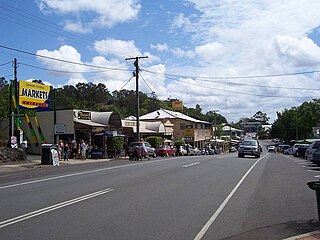
Eumundi is a rural town and locality in the Sunshine Coast Region, Queensland, Australia. In the 2021 census, the locality of Eumundi had a population of 2,504 people.

Carlton House is a heritage-listed boarding house at 3 Mill Street, Toowoomba, Toowoomba Region, Queensland, Australia. It was built from c. 1875 to 1900s. It was added to the Queensland Heritage Register on 31 October 1994.

Coorparoo School of Arts and RSL Memorial Hall is a heritage-listed school of arts at 208 Cavendish Road, Coorparoo, City of Brisbane, Queensland, Australia. It was built from 1892 to 1953. It is also known as Coorparoo School of Arts and Coorparoo Shire Hall. It was added to the Queensland Heritage Register on 6 January 1999.

Lochiel is a heritage-listed villa at 6 Hillside Crescent, Hamilton, City of Brisbane, Queensland, Australia. It was built from 1860s to 1920s. It is also known as Balmoral, Langley Grove, and Runnymeade. It was added to the Queensland Heritage Register on 28 May 1999.

Foresters' Hall is a heritage-listed community hall at 16 Latrobe Terrace, Paddington, City of Brisbane, Queensland, Australia. It was designed by Alexander Brown Wilson and built in 1888 by W Taylor. It was added to the Queensland Heritage Register on 18 April 1997.

Lonsdale House is a heritage-listed detached house at 283 Boundary Street, Spring Hill, City of Brisbane, Queensland, Australia. It was built from 1860s circa to 1950s circa. It was added to the Queensland Heritage Register on 27 August 1999.

Bellmount is a heritage-listed detached house at 71 St Pauls Terrace, Spring Hill, City of Brisbane, Queensland, Australia. It was built from c. 1880 to c. 1900. It was added to the Queensland Heritage Register on 21 October 1992.
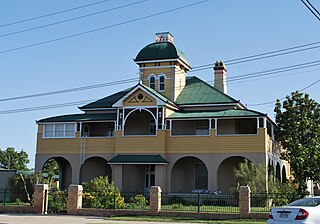
St Mary's Presbytery is a heritage-listed Roman Catholic presbytery of St Mary's Roman Catholic Church at 142 Palmerin Street, Warwick, Southern Downs Region, Queensland, Australia. It was designed by Wallace & Gibson and built from 1885 to 1887 by John McCulloch. It is also known as Father JJ Horan's private residence. It was added to the Queensland Heritage Register on 31 July 2008.

Pine Rivers Shire Hall is a heritage-listed town hall at 238 Gympie Road, Strathpine, City of Moreton Bay, Queensland, Australia. It was built from 1889 to 1935. It is also known as Pine Divisional Board Hall, Pine Rivers Shire Hall, and Pine Shire Hall. It was added to the Queensland Heritage Register on 21 October 1992.

The Eumundi War Memorial Trees is a heritage-listed memorial avenue of trees at Memorial Drive, Eumundi, Sunshine Coast Region, Queensland, Australia. It was built in 1917 onwards. It is also known as Trees in Memorial Drive. It was added to the Queensland Heritage Register on 5 December 1997.

St George's Anglican Church is a heritage-listed church at 15 Cook Street, Eumundi, Sunshine Coast Region, Queensland, Australia. It was designed and built by J Carby in 1912. It is also known as St George's Church of England. It was added to the Queensland Heritage Register on 24 September 1999.
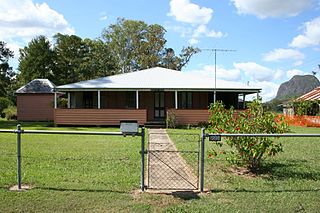
Bankfoot House is a heritage-listed homestead at 1998 Old Gympie Road, Glass House Mountains, Sunshine Coast Region, Queensland, Australia. It was built in 1878. It was added to the Queensland Heritage Register on 11 December 2008.

Landsborough Shire Council Chambers is a heritage-listed former town hall and now museum at 6 Maleny Street, Landsborough, Sunshine Coast Region, Queensland, Australia. It was designed by Walter Carey Voller and built in 1924 by Alfred Ernest Round for the Landsborough Shire Council. It is also known as Landsborough Shire Historical Museum. It was added to the Queensland Heritage Register on 24 June 1999.

Montville Memorial Precinct is a heritage-listed memorial precinct at Razorback Road and Main Street, Montville, Sunshine Coast Region, Queensland, Australia. It was added to the Queensland Heritage Register on 28 August 2008.

Koongalba is a heritage-listed detached house at 12 Wharf Street, Yandina, Sunshine Coast Region, Queensland, Australia. It was built from 1894 to 1920s. It is also known as John Low's House. It was added to the Queensland Heritage Register on 4 July 1995.
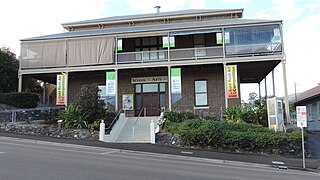
Gympie School of Arts is a heritage-listed school of arts at 39 Nash Street, Gympie, Gympie Region, Queensland, Australia. It was designed by architect Hugo William Du Rietz and was built from 1904 to 1905. It was added to the Queensland Heritage Register on 23 April 1999. It is now home to the Gympie Regional Gallery.

Railway Hotel is a heritage-listed hotel at 1 Station Road, Gympie, Gympie Region, Queensland, Australia. It was designed by Alexander Brown Wilson and built in 1915 by J J Georges. It was added to the Queensland Heritage Register on 12 June 2008.

Synod Hall is a heritage-listed Anglican church hall at 36 Cleveland Terrace, Townsville CBD, City of Townsville, Queensland, Australia. It was built from 1897 to 1898. It is also known as Jubilee Hall and Parish Room. It was added to the Queensland Heritage Register on 21 October 1992.
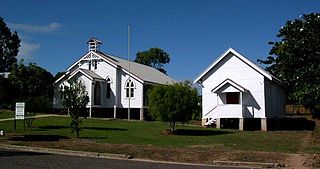
St John's Anglican Church Precinct is a heritage-listed churchyard at 30-34 Macrossan Street, South Townsville, City of Townsville, Queensland, Australia. It was built from c. 1907 to c. 1911. It was added to the Queensland Heritage Register on 21 October 1992.

Aldborough is a heritage-listed villa at 25 Deane Street, Charters Towers City, Charters Towers, Charters Towers Region, Queensland, Australia. It was designed by William Henry Allan Munro and built in 1900 by Thomas Barry O'Meara. It was added to the Queensland Heritage Register on 14 August 2008.























